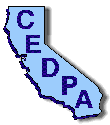
 |
California Educational Data Processing Association |
The DataBus - Vol. 36, No. 5
|
These could be typical reactions from anyone who is accustomed to POTS (Plain Old Telephone Service) a.k.a an analog phone line. With POTS, we have come to expect a "plug and play" environment. It all seems so easy until we try to share the same analog line among the phone, the FAX machine, and our computer's MODEM. In this setup, we would need a device in our home office which would intercept the incoming call and try to decipher which device gets the call based on an incoming tone.
ISDN (Integrated Services Digital Network) on the other hand has no incoming tones--the service is completely digital. Basic rate ISDN uses a device called an "NT-1" to separate the wire to the telco from the wire in the customer's premises. In future issues we will examine more of the functions of the NT-1. ISDN has the concept of a "passive bus". Simply put, this is the wire on the customer's side of the NT-1. You may only have one NT-1 per basic rate ISDN line, but you may connect from one to eight ISDN devices to the passive bus. One mechanism which ISDN uses to distinguish the devices is the SPID (Service Profile Identifier). The SPID in some way resembles the phone number to which it is associated but the final format may vary depending upon the central office switch type and the practices of each particular telco. Here is an example:
Let's assume that we are setting up a home office and we want to have a small ISDN router for telecommuting to our company's network and we want an ISDN phone. The telco is using an ATT 5ESS switch in their central office. The telco gives you two phone numbers: (714) 555-1212 for the phone and (714) 555-1213 for the router. The usual format for the SPID in this case would be 0155512120 and 0155512130, if the 5ESS is using a protocol called ATT Custom. You would need to set the SPID in your phone to: 0155512120. In the router configuration, you would set your SPID to: 0155512130.
Seems pretty simple so far, but if the ATT 5ESS is using a protocol called National ISDN-1 (NI-1) the SPIDs might look like: 714555121200 and 714555121300. This would also force you to setup your router differently when you configure the switch type and this consideration may also affect the choice of your ISDN voice telephone.
When a SPID is incorrectly entered, the device simply will not operate correctly. it is extremely important to have a clear dialog with the telco representative when you order your service. Let the person know exactly what equipment you intend to use. Ask them what type of central office switch services your home. For southern California there are only two choices: ATT 5ESS or Northern Telecom DMS-100. Ask them if they are using National ISDN-1 protocol. When you receive your phone numbers make sure that the telco gives you the associated SPIDs as well--it is the only way to be sure and to save yourself a good deal of frustrating troubleshooting time.
Frank Columbus is a systems engineer and ISDN specialist with Cisco Systems, Inc. He may be reached by e-mail at [email protected].